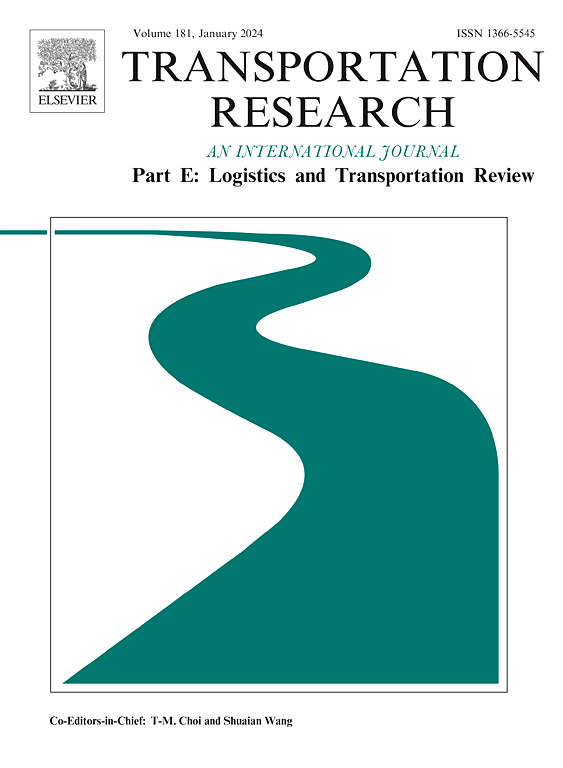全球集装箱航运网络针对两次级联故障的数据驱动复原力分析
IF 8.3
1区 工程技术
Q1 ECONOMICS
Transportation Research Part E-Logistics and Transportation Review
Pub Date : 2024-11-19
DOI:10.1016/j.tre.2024.103857
引用次数: 0
摘要
作为全球供应链和物流系统的重要环节,全球集装箱航运网络(GCSN)具有高度的互联性,极端事件(如 COVID-19 和地区冲突)引发的级联故障给网络的恢复能力带来了挑战。在这一动态过程中,负载再分配行为是应对级联故障传播的核心对策,但其多样化机制尚未得到系统研究。为了填补这些空白,本研究旨在开发一个针对级联故障的开创性弹性分析框架,以全面探讨港口中断对航运网络弹性的影响。通过开创性地分析港口间性、重量和连通性对负载确定和目标选择的影响,应用港口重要性评估方法作为负载再分配决策的基础。基于 2020 年至 2023 年的全球航线数据,通过三个指标量化了全球 686 个港口对连续级联故障的恢复能力。通过情景分析,模拟 5 次历史港口中断事件(如 COVID-19 港口封锁和 2024 年巴尔的摩港口撞桥事件)引发的级联故障对网络弹性的影响。确定已识别的临界容量阈值对于有效提高系统恢复能力和防止出现级联故障的可能性至关重要。此外,本研究还为全球航运业利益相关者提供了前沿视角。它提出了独特的策略和偏好,为港务局的风险应对决策提供了可行的建议。此外,本研究还提供了经济学原理和关键评估,有助于港口基础设施的战略维护、规划和扩建,以防范不可预见的风险。本文章由计算机程序翻译,如有差异,请以英文原文为准。
Data-driven resilience analysis of the global container shipping network against two cascading failures
Being a fundamental link in the global supply chain and logistics system, the global container shipping network (GCSN) is highly interconnected, which causes the network resilience challenges by the cascading failures triggered by extreme events (e.g., COVID-19 and regional conflicts). Within this dynamic process, the load redistribution behaviour is the core countermeasure for the propagation of cascading failures, however the diversified mechanism has not been systematically studied. To fill in these gaps, this study aims to develop a pioneering resilience analysis framework against cascading failures, to comprehensively explore the impact of port disruptions on the shipping network resilience. By pioneering the influence analysis of port betweenness, weight, and connectivity on load determination and target selection, a port importance assessment method is applied as the foundation for load redistribution decisions. Based on the global service routes data from 2020 to 2023, the GCSN resilience against the sequential cascading failures of 686 ports worldwide is quantified by three metrics. A scenario analysis is conducted to simulate the effects of cascading failures triggered by 5 historical port disruption events (e.g., the COVID-19 port lockdowns and the 2024 bridge collision at Baltimore port) on resilience of the network. Determining the identified critical capacity threshold is pivotal for effectively enhancing the system’s resilience and preventing the likelihood of cascading failures. Additionally, this study offers cutting-edge perspectives to the global shipping industry stakeholders. It presents distinct strategies and preferences, offering actionable advice for port authorities in their risk response decisions. Moreover, this study delivers an economic rationale and critical evaluations, instrumental for the strategic maintenance, planning and augmentation of port infrastructures to prevent unforeseen risks.
求助全文
通过发布文献求助,成功后即可免费获取论文全文。
去求助
来源期刊
CiteScore
16.20
自引率
16.00%
发文量
285
审稿时长
62 days
期刊介绍:
Transportation Research Part E: Logistics and Transportation Review is a reputable journal that publishes high-quality articles covering a wide range of topics in the field of logistics and transportation research. The journal welcomes submissions on various subjects, including transport economics, transport infrastructure and investment appraisal, evaluation of public policies related to transportation, empirical and analytical studies of logistics management practices and performance, logistics and operations models, and logistics and supply chain management.
Part E aims to provide informative and well-researched articles that contribute to the understanding and advancement of the field. The content of the journal is complementary to other prestigious journals in transportation research, such as Transportation Research Part A: Policy and Practice, Part B: Methodological, Part C: Emerging Technologies, Part D: Transport and Environment, and Part F: Traffic Psychology and Behaviour. Together, these journals form a comprehensive and cohesive reference for current research in transportation science.

 求助内容:
求助内容: 应助结果提醒方式:
应助结果提醒方式:


